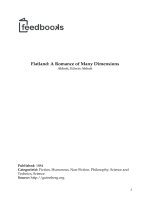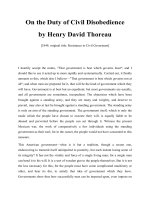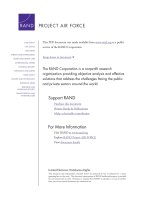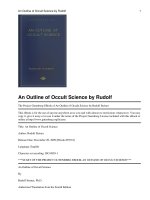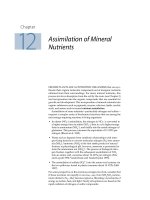Preparation of dairy products potx
Bạn đang xem bản rút gọn của tài liệu. Xem và tải ngay bản đầy đủ của tài liệu tại đây (458.33 KB, 86 trang )
Agrodok 36
Preparation of dairy
products
Pauline Ebing
Karin Rutgers
This publication is sponsored by: ICCO, Interchurch organisation for development co-
operation
© Agromisa Foundation and CTA, Wageningen, 2006.
A
ll rights reserved. No part of this book may be reproduced in any form, by print, photocopy,
microfilm or any other means, without written permission from the publisher.
First English edition: 1985
Sixth revised edition: 2006
A
uthors: Pauline Ebing, Karin Rutgers
Editor: Tineke van der Haven
Illustrator: Bertha Valois
Design: Eva Kok
Translation: W.J. Guijt (revision: Catharina de Kat-Reynen)
Printed by: Digigrafi, Wageningen, the Netherlands
ISBN Agromisa: 90-8573-062-7
ISBN CTA: 978-92-9081-341-5
Foreword 3
Foreword
This Agrodok is meant to serve as a manual for those who want to
start small-scale production of dairy products in developing countries.
The booklet introduces the reader to small-scale dairy production
using simple techniques. It also gives an idea of the opportunities
available to earn some income through cheese making. Locally there
is often much knowledge available on production of dairy products.
We would advise you to get acquainted with such methods in your
area before starting on your own. We would also suggest that you not
introduce Western dairy products if there is no need to do so,
especially if local dairy products are already being made.
The authors have used information provided by the late J.C.T. van den
Berg of the Wageningen Agricultural University in the Netherlands,
who had much experience with factory production of dairy products in
the tropics. The recipes described in this Agrodok have been drawn
from various sources. We would greatly appreciate it if you would
write to us about your experiences with the recipes in this book and
with information on other local recipes. Where possible, they will be
included in a future revised edition.
The sixth, revised edition has been updated with some technological
knowledge about dairy science and dairying techniques and
experience in extension service. However it is utterly impossible to
cover the whole field of dairy technology. To do this, one needs basic
knowledge of dairy chemistry, physics and microbiology, in addition
to hygiene and handling of the milk on farm level. Therefore this
booklet has to be considered as an introduction. Interested readers
have to extend their knowledge by means of further reading and
professional training in some important dairy techniques. The list of
literature references and useful addresses may be of help.
Tineke van der Haven
Wageningen, August 2006
Preparation of dairy products 4
Contents
1 Introduction 6
1.1 What is this booklet about? 6
1.2 Why process milk? 6
1.3 What problems can arise? 8
2 Significance of milk and dairy products for humans 10
2.1 Milk as food 10
2.2 Composition and characteristics of various types of milk 12
2.3 Infant nutrition 13
2.4 Lactose intolerance 15
2.5 Milk and dairy products in the diet 16
3 Hygiene 18
3.1 Deterioration due to micro-organisms 18
3.2 Contamination of milk with extraneous matter 22
3.3 Hygienic production, storage and processing of milk 22
4 Processing techniques 28
4.1 Pasteurisation 29
4.2 Cooling 31
4.3 Souring by fermentation or acidification 33
4.4 Creaming 33
5 Starter cultures 35
5.1 The development of lactic acid bacteria 35
5.2 Cultivation of starter cultures of lactic acid bacteria 36
5.3 Growth of starter cultures 37
5.4 Maintenance of starter cultures 40
5.5 Preparing your own culture 41
6 Recipes 44
6.1 Cream 45
6.2 Sour cream 46
Contents 5
6.3 Butter 46
6.4 Buttermilk and sour milk 50
6.5 Ghee 51
6.6 Koa 52
6.7 Rabi 52
6.8 Yoghurt 53
6.9 Kefir 55
7 Cheese 59
7.1 Utensils for making cheese 62
7.2 The quality of milk used to make cheese 64
7.3 Coagulation of the milk 64
7.4 Separating curd and whey 67
7.5 The use of cheese whey 68
7.6 Collection and preservation of the curd 69
7.7 Maturation of the cheese 71
7.8 Cheese recipes 73
Further reading 82
Useful addresses 83
Appendix 1: Measures 86
Preparation of dairy products 6
1 Introduction
1.1 What is this booklet about?
Livestock is usually kept for various reasons in the tropics such as
traction, the provision of meat, wool, hair, skins and manure which,
when dried, can be used as fuel. Milk is often no more than a by-
product of animal husbandry, although it is a valuable foodstuff.
Furthermore, keeping livestock can be a way of saving. In the event of
an emergency, animals can be sold to provide money. As such, animal
husbandry is also a kind of insurance against, for example, disease and
crop failure.
It is not by accident that a certain kind of milk-producing animal is
kept in a specific area. This is due to climatic conditions, locally
prevalent diseases, available fodder, the possibilities for the owner to
take risks, additional tasks that the animal is expected to do, religion
and tradition and the preference for products that the animal produces.
Keeping dairy animals often leads to a surplus of milk. If milk
production is higher than consumption in a certain area, the surplus
can either be sold on the market, or it can be processed so that it does
not go off. If the quantity of milk to be processed is small (up to 100
litres at a time), this activity is considered to be small scale. This
Agrodok deals with the small-scale processing of milk using simple
equipment.
1.2 Why process milk?
There are many reasons to process milk into dairy products, such as
the following:
? Many dairy products can be kept longer than fresh milk, therefore
the milk does not have to be consumed immediately.
? The demand for fresh milk may be limited, and there may be more
interest in dairy products.
Introduction 7
? If the daily amount of fresh milk for sale is limited, it may be more
economical to process the milk into less perishable products, store
them, and sell them later in greater quantities.
? There may be no market for fresh milk close by, and only preserved
products can be sold at markets at a greater distance.
? Greater financial gain may be obtained.
Apart from these reasons, it should also be realised that many
population groups in Asia and Africa cannot or can hardly consume
milk because of so-called lactose intolerance. Lactose intolerance
implies that the body is almost or entirely unable to digest the milk
sugar, lactose, which is found in milk. Only small amounts of milk (up
to 200 ml) consumed several times a day can be digested. Dairy
products in which a proportion of the milk sugar is converted during
production, such as cheese, curd, yoghurt and sour milk or buttermilk,
do not cause many problems in this respect.
Figure 1: Milk products
Preparation of dairy products 8
Before processing surplus milk, one must consider whether it is
profitable to do so. The processing is not always easy and there may
be losses. For example, a waste product of cheese making is whey,
which contains many valuable nutrients. If the whey is not used, a
valuable part of the milk is lost. Furthermore, while milk is being
processed quality deterioration may occur and it can go off. Only
when milk is drunk immediately can you be sure that nothing is lost.
1.3 What problems can arise?
Small-scale processing of milk means the processing of small
quantities of milk, up to 100 litres at a time, using simple implements
and as little extra equipment as possible. Processing milk in the tropics
can be difficult because of the high temperatures and high relative
humidity often found there. These conditions present special problems
in choosing the right kind of dairy products. Their storage life must
always be taken into account.
High temperatures are bad for cheese making, especially for maturing
cheeses. High temperatures also cause the bacteria already present in
milk to multiply quickly. Milk sugar then turns sour, leading to the
curdling of milk. However, these lactic acid bacteria are not harmful
to humans.
Thorough cleaning of dairy utensils and equipment is essential.
Anyone handling milk must also pay great attention to hygiene. Lack
of hygiene can contaminate milk with other types of bacteria, which
turn it sour and reduce its storage life. The prevention of
contamination is especially difficult when milk is collected from
various places and processed centrally. Addition of even a small
quantity of infected milk contaminates the total quantity of the milk.
A further problem is the lack of equipment. One has to try to manage
with simple dairy equipment, but even this can be difficult to find for
small-scale milk processing. Electricity is usually not available so
electric equipment (e.g. for cooling) cannot be used unless a generator
Introduction 9
is installed. Additives such as rennet for cheese making are often
difficult to obtain in the tropics.
The following chapters discuss the importance of milk in the diet,
hygiene and milk processing techniques.
The second part of the booklet gives guidelines for heating, cooling
and fermentation and for the processing of cream, butter, ghee, sour
dairy products and cheese.
Figure 2: Sheep provide milk, meat, wool, skin, pelts and manure
Preparation of dairy products 10
2 Significance of milk and dairy
products for humans
2.1 Milk as food
Milk contains components that
are essential to humans such as
proteins, carbohydrates, fat,
water, all the B-vitamins,
vitamins A and D, calcium and
phosphorus. It also provides
energy.
An important protein in milk is
casein (in many cases 80% of
the milk protein). This is the
base for cheese making. Casein
is linked to calcium phosphate, which is why milk contains a
relatively large amount of this salt that is a very important nutrient for
humans and animals.
In addition to casein, milk contains whey proteins (20% of the milk
protein). The whey proteins are in most cases not incorporated in the
cheese; they remain in the whey. Whey proteins (globulins and
albumins) have a very high nutritive value.
Milk protein is of a high quality. This means that the human body can
use a large part of the protein efficiently. Proteins in various other
foodstuffs have a complementary effect. In combination with cereals,
potatoes, meat, eggs or nuts in one meal, the body can use an even
greater percentage of the milk protein.
Apart from milk, there are other animal protein sources such as fish
and meat. Vegetable protein, which is also important in making the
body's proteins, is found in cereals and pulses. Protein is needed by
Figure 3: Main components of milk
Significance of milk and dairy products for humans 11
the body for growth, replacement of worn-out body proteins and the
production of compounds that the body needs.
Milk sugar (lactose) is a carbohydrate, a necessary component to keep
the body going. Our bodies burn carbohydrates in the same way an
oven burns wood. Through this combustion, energy is released which
is used by our bodies for many kinds of activities.
Milk fat is present in the form of small fat globules, which have a
lower weight than the other components of the milk. When cow milk
is allowed to stand, these globules collect on top of the milk and form
a layer of cream. Buffalo milk also forms some cream on top, but
other kinds of milk, such as that of sheep and goats, hardly form a
layer of fat at all. For these types of milk one needs to separate the
cream from the milk. Milk fat is easy to digest. The body uses fat as a
fuel or stores it as fat reserves.
Milk is also an important source of minerals and vitamins. It contains
large quantities of calcium, which can easily be absorbed by the body
after digestion and is important for the formation of bones (the
skeleton). Milk is also an important source of vitamin B2 (Riboflavin),
but there is little vitamin C in milk. Therefore a person's diet must also
include vegetables and fruits in order to ensure a sufficient supply of
vitamin C.
Milk is able to compensate for a lack of certain nutrients in a
monotonous diet because of the great diversity of nutrients it contains
and the high value of milk protein. It can therefore greatly improve the
quality of the diet. Products derived from milk contain these nutrients
to a greater or lesser extent. Milk is especially desirable for vulnerable
groups, for instance babies, toddlers, children and pregnant and
nursing mothers. Always strive for a healthy, varied diet, which apart
from milk also includes cereals, pulses, vegetables, fruits and if
possible meat or fish.
Preparation of dairy products 12
The various types of milk differ in various ways, including nutritional
value. In the next pages this is dealt with in more detail.
2.2 Composition and characteristics of various
types of milk
The composition of mother's milk and milk from cow, buffalo, goat,
sheep, camel, donkey and lama is shown in table 1. The figures in
table 1 show that the composition of the milk of non-ruminants, e.g.
mother’s milk and mare milk, differs distinctly from the milk of
ruminants (cow, goat, sheep, etc.). This may be partly explained by
differences in the digestive system of the two groups.
Apart from the differences in cream formation there are other
differences between the various kinds of milk. There is a lot of pro-
vitamin A (carotene) in cow milk, giving it its yellow colour, but not
in buffalo, goat or sheep milk. In the milk of goats and sheep the
carotenoids are already converted into the colourless vitamin A. This
is why only cow milk is yellow in colour.
Table 1: Composition of various types of milk (source: FAO
Nutritional Studies 27)
Milk source fat (%) protein (%) lactose (%) calcium (%)
energy
(cal/100g)
Human
(mother’s) milk
4.6 1.2 7.0 0.0 73
Friesian cow 3.5 3.3 4.6 0.1 62
Guernsey cow 4.7 3.2 4.7 0.1 75
Indian buffalo 7.5 3.8 4.9 0.2 100
Goat 4.5 3.3 4.4 0.1 71
Sheep 7.5 5.6 4.4 0.2 105
Mare 1.6 2.2 6.0 0.1 47
Donkey 1.5 2.1 6.2 0.1 46
Camel 4.2 3.7 4.1 ? 70
Lama 3.2 3.9 5.3 ? 65
Significance of milk and dairy products for humans 13
Buffalo milk curdles sooner than cow milk. Unless the preparation is
adjusted, cheese made from buffalo milk will mature more slowly and
have a drier consistency than cheese made from cow milk. Goat milk
can have an unpleasant smell; this can be prevented by boiling the
milk as soon as possible after milking. Between some goats or breeds
of goats there may be a difference in the taste of the milk.
Cow milk accounts for 91% of the world's milk production. Buffalo,
goat and sheep milk account for 5.9%, 1.6% and 1.7% respectively.
Although there are enormous regional differences we can generally
say that, if it is to be drunk, milk from cows or buffaloes is preferred
to that from goats and sheep. This is because of the more neutral
flavour of cow milk and buffalo milk.
Goat and sheep milk are, just like the milk of cows and buffaloes,
popular for making cheese and soured milk products (especially sheep
milk). Camel milk is usually drunk. Mother’s milk is the most ideal
food for a suckling infant. Nonetheless, many substitutes have been
developed which find a ready demand. We shall pay more attention to
infant nutrition in the next section.
2.3 Infant nutrition
Mother’s milk is best suited to the needs of a baby, and contains
certain components that protect an infant against infectious diseases.
All the nutrients a baby needs, except iron and vitamin C, are to be
found in sufficient quantities in mother’s milk. At birth, a baby has a
store of iron in its liver, which it uses up during its first 6 months. Any
kind of supplementary feeding is only necessary after 3 months, as the
mother's milk then no longer supplies all the nutrients the infant needs.
Fruit juice and mashed fruit provide additional vitamin C, which the
infant then needs. Supplementary feeding of energy-giving foods is
also desirable. Mixing small quantities of milk powder into mashed
food can considerably improve the food's value (especially the value
of its protein).
Preparation of dairy products 14
It is advisable to continue breastfeeding as long as possible because
mother's milk is often the only source of animal protein for a baby. If
the mother cannot breastfeed, does not have enough milk or dies,
bottle feeding is a solution and the best substitute. However, in
practice often too much water is added to the (artificial) baby food,
which is usually bought in powder form. It becomes too watery and is
therefore not nutritious enough. Moreover, artificial foods are costly
and require good hygiene. Dilution with water is often a cause of
infection because the available water may be polluted. Water used for
bottle feeding must first be boiled, but sterilising water by boiling uses
a lot of fuel, which is often in short supply. By using a cup or a spoon
it is easier to maintain the necessary hygiene rather than a bottle
because they are easier to clean.
Figure 4: Breastfeeding is the healthiest and most hygienic way to
feed a baby
Money might be better spent on essential necessities of life than on
artificial infant food if the latter is not strictly necessary. If a baby
cannot digest milk, you will be forced to use milk products, which do
not contain lactose. This is the case with inherited lactose intolerance.
We shall discuss this in more detail.
Significance of milk and dairy products for humans 15
2.4 Lactose intolerance
Lactose intolerance means that the human body is almost, or entirely,
unable to digest the milk sugar, lactose, which is present in milk
because the body lacks the enzyme lactase. Lactase splits the lactose
into glucose and galactose. The latter two mono-saccharides can easily
be absorbed in the intestine.
Undigested lactose can be converted by the microbial flora in the
intestine into lactic acid and gases. Consumption of larger quantities
of milk thus causes flatulence, stomach cramps and diarrhoea.
‘Lactose intolerance’ is thus often called ‘lactase deficiency’.
There are different forms of lactose intolerance among children:
? Congenital lactose intolerance. In this case, a baby cannot digest
milk because the baby lacks the enzyme lactase, necessary for the
breakdown of lactose into glucose and galactose.
? Lactose intolerance among children who are 2-5 years old. From the
age of two years lactase activity in a child decreases and the child
may have problems due to insufficient lactase by the time he or she
is 4-5 years old. Consumption of small quantities of milk (one glass
at a time) usually does not cause any problem. It is also possible to
prevent problems by eating fermented milk products, in which part
of the milk sugar has been converted, such as cheese, yoghurt and
buttermilk.
? Lactose intolerance as a result of intestinal disease and/or
malnutrition, especially in babies and toddlers. The lactose activity
is temporarily decreased making it necessary to use lactose-free
milk products for a short time. Cheese and fermented products like
yoghurt, in which milk sugar has been converted, are also suitable.
Apart from lactose intolerance, the use of milk also depends on other
factors, which we will now discuss.
Preparation of dairy products 16
2.5 Milk and dairy products in the diet
Diet refers to the way people feed themselves and the foodstuffs they
use to do so. This is strongly influenced by people’s traditions and
religion, their economic position, their place in society and the
possibilities offered by their natural surroundings. It is not surprising
that each population group has its own diet. The use of milk and dairy
products can also be looked at when examining the diet.
Here are a few examples of how the factors mentioned above can
influence the role and form of milk and dairy products in the diet.
? The cow is a sacred animal in India; therefore the rennet used in
cheese making may not be taken from a calf's stomach.
? If milk or dairy products have to be bought, money is needed.
? In densely populated areas, people are forced to use all available
land for crops that give a maximum yield, or crops that can be
directly consumed by the people. This limits the land available for
dairy farming.
? It may not be possible to keep cattle in certain regions, e.g. the
humid tropics, due to the natural environment. For example, in
humid areas of West Africa cattle cannot be kept because they are
the host of the tsetse fly, which transmits sleeping sickness.
For these reasons, milk and dairy products in the diet can be of greater
or lesser importance in one area or another. Economic and social
situations are especially subject to change and dietary patterns change
with them.
New foodstuffs may be introduced to (partly) substitute others.
Adoption of new products is often no easy matter; sometimes
centuries-old traditions may have to change. Also, taste and other
characteristics such as texture are important in the acceptance of new
kinds of food. Something that may be considered very tasty in one
place, may not be appreciated elsewhere.
Significance of milk and dairy products for humans 17
Figure 5: Camel milk is a very popular food in parts of Africa and
the Middle east
Preparation of dairy products 18
3 Hygiene
Milk should be handled with care. There are several factors that can
make milk go off and become unsuitable for further consumption.
These include:
? the presence of too many micro-organisms in the milk
? contamination by diseased animals (tuberculosis, brucellosis) and/or
people
? bacterial and/or chemical conversion of certain substances in the
milk
? contamination of the milk with antibiotics (used for treatment of
diseased animals), disinfectants, pesticides and so on.
The above-mentioned factors always cause some deterioration of milk.
In some cases it is only the flavour that is affected, but usually the
structure and smell of milk also change. In the case of contamination
with antibiotics and disinfectants, the milk’s appearance does not
change, but fermentation, which is necessary for processing the milk,
is inhibited.
We will first discuss the way micro-organisms cause the deterioration
of milk. Then precautions which can be taken to minimise the impact
of these factors will be explained, and some suggestions for cleaning
and disinfection will be given.
3.1 Deterioration due to micro-organisms
Bacteria, yeasts and moulds are all called: micro-organisms.
Micro-organisms are very small and cannot be seen with the naked
eye. They are found everywhere in nature: in the air, water, and soil
and also in food and milk. Micro-organisms can multiply very rapidly.
Milk in the udder of a healthy animal contains almost no micro-
organisms (aside from lactic acid bacteria). After the milk leaves the
Hygiene 19
udder contamination with, sometimes harmful, micro-organisms will
take place during milking, milk handling, transport and storage. Milk
may be contaminated with micro-organisms originating from the skin
of the animal, the milker’s hands, the milking utensils or the air.
Most micro-organisms are not harmful, but some can cause diseases
like salmonella infection, dysentery, tuberculosis (in man and in
animals), diphtheria and typhoid. These disease-causing micro-
organisms are called pathogenic bacteria. Through inadequate
hygiene, diseases can be transmitted from person or animal to person.
Figure 6: Diverse sources of contamination: a shows badly
cleaned utensils contaminating milk; b improper milking is also a
source of contamination; c shows multiplication of micro-organisms
during storage; d heating kills the micro-organisms.
Micro-organisms can multiply very rapidly in milk. Temperature plays
an important role in the life of micro-organisms. Their growth can
start at a temperature of about 4°C. It is therefore very important to
Preparation of dairy products 20
store milk or milk products at a temperature no higher than 4°C;
otherwise deterioration will take place rapidly. Above 20°C, bacteria
multiply at an incredible speed.
Figure 7: Temperature and deterioration
Most micro-organisms are killed during pasteurisation, e.g. at a
temperature above 63°C for a period of at least 30 minutes. But a few,
the so-called spore-forming bacteria, will survive more intense
heating. They can give problems like off flavours and coagulation in
pasteurised milk.
Yeasts and moulds
Yeasts are micro-organisms that can ferment sugars into alcohol, gas
and other substances. They are about 5-10 times larger than bacteria.
Reproduction usually takes place through budding. Yeasts usually
grow in an acid environment; they need oxygen and they can
withstand rather high concentrations of acids.
In dairy products, yeasts are usually found in soured products like sour
milk or buttermilk, sour whey, butter, and curd and on the surface of
cheese. When present in large numbers, they produce gas and they
cause undesirable off flavours of the product.
Moulds are string-like micro-organisms. The fine threads, called
mycelium, are large enough to be seen with the naked eye. To develop
they need atmospheric oxygen, and they thrive best in humid and acid
conditions. Moulds multiply by forming spores. These float easily
through the air and can often be found on poorly maintained ceilings
Hygiene 21
and walls. Their mobility makes them an important source of
infection.
Moulds can be seen on the surface of butter or cheese in the form of
coloured spots. For some soft cheeses (like Camembert and Brie)
moulds are essential for ripening. In general, moulds are harmless, but
some produce poisonous toxins (mycotoxins), such as aflatoxin in
peanut products.
Cells and spores of moulds and yeasts are destroyed by pasteurisation
(heating the milk 30 minutes at 63°C or 20 seconds at 72°C).
Bacteria
Bacteria are single-cell micro-organisms that multiply by cell division.
Raw milk and many dairy products contain many different kinds of
bacteria. Environmental conditions (such as acidity, temperature,
humidity or amount of oxygen) can change, making conditions less
attractive for one group of bacteria but at the same time creating
optimal conditions for another type. This is why some families of
bacteria will always be found in milk or dairy products (lactic acid
bacteria).
An exception must be noted, which is dried products like milk
powder. Micro-organisms cannot grow without water and therefore the
number of bacteria in uncontaminated milk powder will be low.
Bacteria found in milk can be divided into two groups: useful and
harmful. Lactic acid bacteria (e.g. Streptococcus lactis) are useful.
They produce lactic acid, which is not harmful and gives milk a fresh,
sour taste. Moreover lactic acid is a good preservative for the sour
products. Pathogenic bacteria (those that cause diseases in humans)
cannot grow in acid products. When producing certain dairy products
like soured milk, yoghurt and cheese, good use is made of these
specific properties (see chapter 5).
Preparation of dairy products 22
Sometimes milk is spoiled by the growth of bacteria that do not
produce lactic acid. In this case, certain disease-causing bacteria can
develop and whey separates from the milk. This usually happens after
long storage of pasteurised milk. The smell is unpleasant and the taste
bitter. Such milk should not be consumed.
3.2 Contamination of milk with extraneous
matter
Extraneous substances must be prevented from entering into the milk.
These can be dangerous to one’s health or cause unpleasant flavours
and smells, reducing the suitability of milk for further processing.
Some examples are cleaning and disinfecting agents, medicine,
pesticides and pieces of metal or glass. The feed given to animals,
such as some weeds, onions and cabbage, can also influence the taste
of the milk. This can be avoided by feeding the animals after milking.
Good hygiene can reduce deterioration. How to achieve a good level
of hygiene will be discussed in the following pages.
3.3 Hygienic production, storage and
processing of milk
Contamination occurs when micro-organisms enter into the milk.
Possible sources of contamination during production, storage and
processing are:
? inflammation of the udder (mastitis)
? the animal itself: skin of teats and udder
? conditions at the milking place (floor, dung, dust, dirty water, etc.)
? the person milking
? utensils and equipment used during processing
? the air and environment
It is no easy task to keep micro-organisms out of milk. Much depends
on the person who is milking, the care taken of the animals and the
cleanliness of the utensils. If everything is well sanitised and kept
clean, relatively few micro-organisms will enter into the milk. Good
Hygiene 23
hygiene is of major importance. In addition, milk - if not used or
processed immediately - should be cooled after milking and kept cool.
Good hygiene measures therefore:
? Prevent contamination of the milk.
? Prevent bacterial growth through good refrigeration of the milk.
Hygiene during milking
There are several possible causes of contamination during milking.
In a normal, healthy cow very low numbers of bacteria are found
inside the udder and the teats. Cows possess various mechanisms to
prevent the entry of bacteria. To avoid problems while milking, it is
important that an animal become accustomed to the activity. It will
then know that it will be milked, and will react positively to it. Such
positive behaviour can start if, for instance, it hears milk cans
clanging, feels its udder being cleaned, etc. Then the animal is easier
to milk and gives more milk. Stress and unrest make the cows move
too much and kick; consequently more dirt and manure can enter into
the milk.
When a cow has an udder infection (mastitis), its milk will be
contaminated with the bacteria that cause the udder infection, and that
may produce pus and sometimes blood. Milk from these animals
should not be used in any way. Mastitis can be prevented by
maintaining good hygiene and avoiding injury to the teats during
milking. An infected udder is not always easy to see. When an udder
infection occurs, it is advisable to remove milk from the udder very
frequently (e.g. every 3 hours by hand). The number of micro-
organisms in the udder is thus reduced. Be aware, however, that
milking an infected udder by machine or by hand is often painful for
the animal. The animal will kick frequently and this can be an
important source of contamination of healthy cows.
Bacteria can be transferred from the skin or teats to the milk, even
with healthy dairy cattle. It is therefore important to clean the udder
Preparation of dairy products 24
before milking. Wipe the udder clean with a dry, clean, preferably
disposable cloth to prevent infection. If the teats or udder are really
dirty, they must first be washed with clean, hand-warm water and a
clean cloth and then dried with a clean towel. Cleaning the udder
improves the cleanliness of the milk and makes milking easier. Skin
and hair can also be sources of infection.
Do not feed animals first before milking, it may create a lot of dust.
See to it that the floor is clean, and be careful when clearing dung,
mud or dust. A clean, well-illuminated milking place and fresh
surrounding air are essential to maintaining good hygiene. Insects
such as flies and cockroaches can also be sources of infection. Try to
control them as they can carry many bacteria and viruses.
When milking, the milk is caught in a pail or bucket. Dirty milking
equipment is the main source of infection of milk.
If residues of milk remain in the equipment because of improper
cleaning and drying, bacteria will develop in these residues. These
bacteria are already accustomed to the milk and will multiply rather
quickly during transport and storage of milk in the equipment. Use
pails and buckets that are smooth on the inside, for instance seamless
metal buckets.
All milking equipment should be thoroughly cleaned immediately
after each use. Use soap or other detergents if necessary. Make sure
that the water used is clean. If you are in doubt, boil it for several
minutes or add chlorine. Very important: after cleaning, the equipment
should be stored upside down in such a way that the inside of the
buckets and cans dry. This prevents the remaining bacteria from
growing.
The person milking plays the most important part in maintaining
proper hygiene during production. He or she keeps an eye on the
condition of the animal, chooses the milking place and cleans all the
equipment. He or she should have clean hands and wear clean clothes.
Hygiene 25
If the milker suffers from tuberculosis, salmonella infection, dysentery
or some other disease, the risk of contamination of the milk becomes
very high; it would be wise to have somebody else take over. This is
also the case if the milker has open wounds or ulcers.
Hygiene during storage and processing
By now you should know that milk should be processed as quickly as
possible after milking and that it should be properly stored in order to
minimise its chances of spoiling.
It is best to filter fresh milk through a filter or clean cloth. This will
remove visible dirt that might have entered into the milk. Clean or
replace the cloth during filtering or filter the milk several times. The
cloth should be thoroughly cleaned after use and then left to dry in the
sun.
In tropical conditions, raw milk, i.e. non-pasteurised milk, goes off
within a few hours. It must therefore be kept cool and quickly
pasteurised and again cooled to a temperature of 4°C if possible.
Properly pasteurised and cooled milk can be kept for a few days, even
in a warm climate.
If you are not able to cool milk below 10°C, then do not mix different
batches. Even if the older milk is still good, you will end up with an
increase in bacterial growth and reduction of the overall quality. Use
clean equipment for storage. Containers that are clear, such as glass,
should be stored in the dark as light reduces the quality of milk. Clean
your equipment with clean water.
Cleaning and disinfection
Utensils must be cleaned in such a way that all dirt, food residues,
feed and micro-organisms are removed from the surface of the
equipment. Dirty saucepans, jugs, milking equipment and utensils
should be cleaned immediately after use. Washing soda (sodium
carbonate) dissolved in hot water is an excellent cleaning agent. It
may be useful to disinfect equipment in order to kill any remaining

